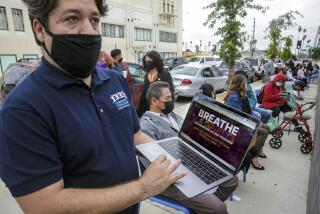Why get off welfare?
- Share via
Contrary to stereotypes, there is no evidence that people on welfare are lazy. Indeed, surveys of welfare recipients consistently show their desire for a job. But there is also evidence that many are reluctant to accept available employment opportunities. Despite work requirements included in the 1996 welfare reform, the U.S. Department of Health and Human Services says less than 42% of adult welfare recipients participate in work activities nationwide. Why the contradiction?
Perhaps it’s because, while poor people are not lazy, they are not stupid either. If you pay people more not to work than they can earn at a job, many won’t work.
A new study by the Cato Institute found that in many states, it does indeed pay better to be on welfare than it does to work.
Most reports on welfare focus on only a single program, the cash benefit program: Temporary Assistance for Needy Families. This focus leaves the misimpression that welfare benefits are quite low, providing a bare, subsistence-level income. In reality, the federal government funds 126 separate programs for low-income people, 72 of which provide either cash or in-kind benefits to individuals.
Because there are so many categories of welfare recipients and so many different types of benefits, it is extremely difficult to determine how many people get what combination of benefits. For the purposes of this study, we assumed a hypothetical family consisting of a mother with two children, ages 1 and 4, and calculated the combined total of seven benefits that family could receive in all 50 states.
If that mother received Temporary Assistance for Needy Families, it is almost certain that she would also receive food stamps and Medicaid as well. Roughly 87% of Needy Families do.
Approximately 61% of all Needy Families fitting our profile also receive aid from the Women, Infants and Children program, or WIC, so we included that benefit. (If the children were older, they would not be eligible for WIC but would receive other benefits such as subsidized school lunches and breakfasts.) We also included utilities assistance, given that half of welfare recipients are on that program.
Housing assistance was a tougher call. Nationwide, the rate of participation varies from nearly 82% of Needy Families in North Dakota to virtually none in Idaho. Housing programs also generally have waiting lists, meaning long-term welfare beneficiaries are most likely to receive benefits. Many states also prioritize families with young children like our profile family. We decided not to include those benefits for states where participation was less than 10%. In California, it is 11.4%.
Finally, we included the federal Emergency Assistance Food Program, which provides free commodities like milk and cheese. Our profile family would qualify in all 50 states, although usage figures are imprecise.
In Washington, D.C., and 10 particularly generous states — Hawaii, Vermont, Connecticut, Massachusetts, New York, New Jersey, Rhode Island, Maryland, New Hampshire and California — these seven programs provide a mother with two young children an annual benefit worth more than $35,000 a year. The value of the package in a medium-level welfare state is $28,500.
That may sound low, but it’s important to remember that welfare benefits are not taxed, whereas wages are. So to put the welfare benefit package in perspective, we calculated the amount of money our recipient would have to earn in pretax income to bring home an equal amount of money if she took a 40-hour-per-week job.
After computing the federal income tax, the state income tax and payroll taxes, as well as taking into account federal and state earned income tax credits and the child tax credit, we came to the inescapable conclusion that welfare pays very well.
In fact, in 33 states and the District of Columbia, welfare pays more than an $8-an-hour job [see chart]. In 12 states, including California, as well as the District of Columbia, the welfare package is more generous than a $15-an-hour job. In Hawaii, Massachusetts, Connecticut, New York, New Jersey, Rhode Island, Vermont and Washington, D.C., welfare pays more than a $20-an-hour job, or more than 2.75 times the minimum wage.
But how does the package compare with salaries for everyday jobs? In California and 38 other states, it pays more than the starting wage for a secretary. California isn’t one of the 10 states (plus the District of Columbia.) where welfare pays more than the average pretax first-year wage for a teacher, nor is it among the three most generous states, where welfare benefits exceed the entry-level salary for a computer programmer. But California welfare benefits can still exceed 96% of the state’s median salary.
Of course, not every welfare recipient meets the study’s profile, and many who do don’t receive all the benefits listed. (On the other hand, some receive even more.) Still, what is undeniable is that for many recipients in the most generous states — particularly those classified as long-term recipients — welfare pays substantially more than an entry-level job.
By not working, welfare recipients may be responding rationally to the incentives our public policy makers have established.
And yet we know that over the long term, a job is better than welfare. Census figures show that only 2.6% of full-time workers are poor, compared with 23.9% of adults who do not work. And, while many anti-poverty activists decry low-wage jobs, even starting at a minimum-wage job can be a springboard out of poverty.
As a result, if Congress and state legislatures are serious about reducing welfare dependence and rewarding work, they should consider strengthening welfare work requirements, removing exemptions and narrowing the definition of work. Moreover, states should shrink the gap between the value of welfare and work by reducing current benefit levels and tightening eligibility requirements.
Michael D. Tanner is a senior fellow at the Cato Institute and the author of “The Poverty of Welfare: Helping Others in Civil Society.”
More to Read
A cure for the common opinion
Get thought-provoking perspectives with our weekly newsletter.
You may occasionally receive promotional content from the Los Angeles Times.










